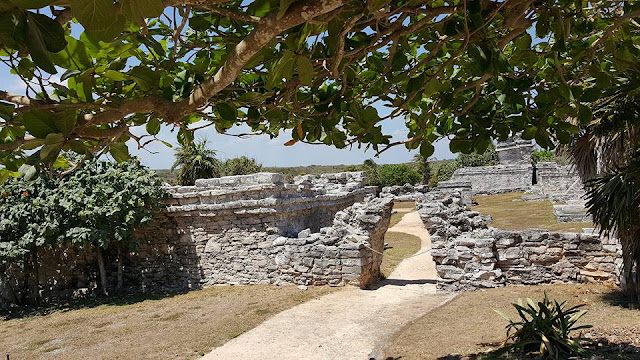The Mayan city of Tulum stands 130 km south and 700 years away of Cancun. But the contrast between the two can be measured in more than just distance and time.
Cancun is a string of large resort hotels which did not exist prior to 1974 and which specialize in the expected. Tulum, on the other hand, was built late in the thirteenth century, during what is known as the Mayan post-classic period.
Each Mayan city had a specific purpose, and Tulum was no exception. It was a seaport, trading mainly in turquoise and jade.As well as being the only Mayan city built on a coast, Tulum was one of the few protected by a wall.
Made of limestone, the 784-metre wall encloses the site on three sides, is seven metres thick, and varies between three and five metres in height. No doubt this fortification helped preserve the seaport.
Like the questions which surround the decline of the Mayan world, there are several theories as to why a wall surrounds Tulum. One has a Mayan population of 600 on the inside, protected from invaders. Another suggests only priests and nobility were housed within the walls, while peasants were kept on the outside.
After entering the ruins through one of five doorways in the wall, visitors are greeted by a field of gently-rolling hills. Black and grey stone outcroppings, which were once buildings, dot the sun-baked landscape.
Here visitors realize that what is left of Tulum can spark the imagination. Given that the seaport was once a link with the outside world, can there be any clues as to what happened to the civilization here? It's a question historians and archeologists still grapple with, so don't be discouraged if an answer isn't obvious.
Most prominent among the remaining structures is the Castillo, or castle, which is perched on the edge of a 12-metre limestone cliff, overlooking the Caribbean coast. Negotiating its steep steps is best done sideways, a fact which will assert itself on the way down.
Before descending, though, be certain to catch a glimpse of the Caribbean behind the Castillo. The view is as refreshing as the cool breeze coming from the sea.
In front of the Castillo is the Temple of the Frescoes, one of the better preserved buildings. Peer inside the temple to see a mural painted in three sections. The first level represents the Mayan world of the dead, the middle is that of the living, and the final, highest piece, is of the creator and rain gods.
Interesting to note in the middle of the living section is a god astride a four-legged animal believed to be a horse. If in fact this is a horse, it would mean Mayans still occupied Tulum in 1518 when they would have seen the animals for the first time with the arrival of the Spanish.
Chiselled above the doorway of the temple is a figure with what appears to be bird's wings and a tail. This diving god is believed to represent a Mayan deity who protected the people and is particularly well-preserved on various buildings around the site.
Piecing together what Tulum was like a millenium ago is exciting, but it can also be a humid venture. That's why it's a good idea to take something cold to drink, a hat and a bathing suit.
Just north of the Castillo is a pathway that leads down to a sandy beach and the multi-hued Caribbean. For visual drama, a walk along the beach provides ample opportunity for photographs. The walk is an adventure into, around and under nooks and crannies carved out of the cliffs. Each additional turn brings a new, secluded stretch of the Caribbean, perfect for both swimming and reflecting on the ruins.
Tulum remains popular because of its elegant setting on sheer limestone cliffs above the turquoise splendour of the crashing Caribbean, the only Mayan city built on the coast.
How to get to Tulum
The ancient Maya ruin of Tulum is a 2 hour drive from Cancun (130 km). There is easy access via Federal Highway 307 from Cancun to Tulum. It's unofficially the southern end to the Riviera Maya. In Cancun there are several travel agencies that organize guided visits and the local bus lines offer regular service between Cancun and the site. The site has a parking lot, refreshments and restrooms located at the shopping center. Tickets are sold at the entrance to the ruins.
A good option is to take a tour to visit Tulum and Xelha ecko park in the same day, this is an excellent combination of activities for an unforgettable day.
A good option is to take a tour to visit Tulum and Xelha ecko park in the same day, this is an excellent combination of activities for an unforgettable day.
Image by Tatjana Dimitrijevic, OC; tulum.com





Blogger Comment
Facebook Comment